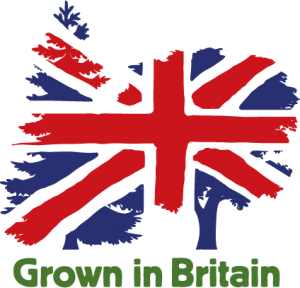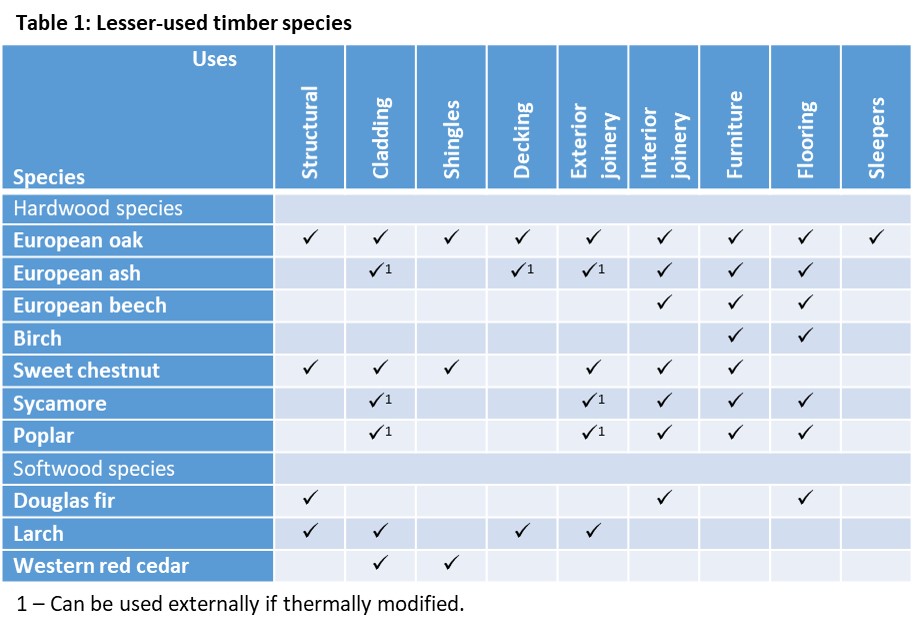Specifying lesser-used UK timber species

Charlie Law March 2019 Responsible Sourcing
In September 2016, the partners on the Grown in Britain (GiB) WoodStock project published their final report on how the UK could make better use of its timber resource. One of the findings highlighted was the UK’s current infatuation with one hardwood species, oak.
Hardwood consumption
At the time of the report, total UK sawn hardwood consumption was stated as 526,000m3 by the Forestry Commission, with the UK production element of this estimated at only 47,000m3. From surveys conducted with UK processors, the GiB Woodstock report estimated that oak made up almost 90% of UK production at 42,000m3. For imports of sawn hardwood, the story is much the same. The Forestry Commission figures state that a total of 496,000m3 of sawn hardwood was imported in 2014, of which 253,000m3 was imported from EU countries, with 168,000m3 of this being oak. Using this data, and including imports from outside the EU (there is no breakdown of species for imports from outside the EU), the GiB Woodstock report estimates that a total of 268,000m3 of oak is likely to have been imported into the UK, which is 54% of all hardwood imports.
Looking at the latest import and production data for 2017, the situation does not appear to have changed. Therefore, allowing for a small proportion that is likely to have been exported, oak consumption in the UK is likely to be sitting at around 300,000m3 per annum, which is more than 50% of all hardwood consumption.
Hardwood availability
The Forestry Commission has also issued a report on the 50-year forecast of hardwood timber availability in the UK. The report stated that there was a significant amount of standing timber available for felling, and although many in the UK timber industry believe the quantities quoted are too high, most agree that there is scope to at least double the amount of hardwood timber sourced from UK woodlands. One species likely to increase in availability over the next few years is ash; this is because of the effects of Chalara (ash dieback). However, further action is required to ensure these quantities are made available, as evidence from sawmills suggests that only a fraction of this timber is making its way to market. This is because there is little or no management of the majority of UK woodland where hardwood species sit, and this must change if the UK is to ensure a continued supply of home-grown timber.
The GiB WoodStock study looked at the availability figures and concluded that:
- Based on conservative estimates, only 10% of the timber extracted is likely to be suitable for saw quality logs, with the remainder going into the biomass market.
- The key species likely to be available are:
- ash
- beech
- oak
- poplar
- sweet chestnut
- sycamore
Based on this data, there is little scope to increase production of oak in the UK, and with one of our key alternative sources of oak being France, Europe’s largest oak producer, already reporting that it is struggling to keep up with demand from countries such as China, continuing to focus on this species is not a sustainable situation. The UK must, therefore, start to promote the use of the other sustainably sourced species to ensure it has a balanced timber market in the future.
Lesser-used species options
Looking at the key species highlighted in the GiB WoodStock study there is significant scope to use lesser-used hardwood, and softwood, species. TRADA’s Wood Species Database contains more than 150 commercial species of timber, with details of their properties and uses. In addition, TRADA’s Wood Information Sheet 2/3-67, Specifying British Grown Timbers, also gives detailed information on alternative timber species that could be used in place of imported timber species, and includes species that may be suitable for thermal modification.
Based on this information, GiB carried out a research and development project that demonstrated how thermal modification would work on a range of British hardwood timbers. Vastern Timber, based in Royal Wootton Bassett, has taken this research and developed a range of thermally modified ash, sycamore and poplar, which it calls Brimstone. This modified timber can be used for cladding, decking and external joinery.
Table 1 below lists some of the lesser-used timber species that could be specified for use in various applications, based on the TRADA Wood Information Sheet 2/3-67.

These timbers all have their own unique look and individual properties that can vary between the timber species, so it is always worth consulting with your timber supplier or the TRADA technical team if you would like to use a species that you have not previously specified for a project to ensure you can use the species for the intended purpose. One example of where specification changes were made was in the recent fit-out of a Wagamama restaurant. Previously, the specification had called for character French oak for the tables and benches, but due to its rising cost this was changed to GiB ash, which was around half the price.
Although the timber species in table 1 should have good availability, based on the Forestry Commission data, not all will be available in sufficient quantities from UK woodlands certified against the UK Woodland Assurance Standard (UKWAS), which is required for Forest Stewardship Council (FSC) and Programme for the Endorsement of Forest Certification (PEFC) chain of custody certification. However, an increasing amount of UK Woodland is being certified under the Grown in Britain (GiB) standard (requiring the woodland to be managed in accordance with the UK Forestry Standard), which allows this timber to be moved under the GiB chain of custody standard. FSC, PEFC and GiB will all help demonstrate compliance with the EU Timber Regulation requirements, and all are accepted as demonstrating legal and sustainable sourcing under the UK government’s Timber Procurement Policy.
When used for structural applications, the timber will need to meet the requirements of BS EN 1912 Structural Timber. Strength classes. Assignment of visual grades and species. Larch, Douglas fir, sweet chestnut and European oak all meet various strength classes under this standard, so depending on your structural loadings, any of these could be used.
As with oak, sweet chestnut and western red cedar both contain tannins which are acidic, so care needs to be taken to avoid iron staining and corrosion of fixings. It is therefore recommended that stainless steel fixings are used for these timbers when used in damp conditions, for example cladding.
Conclusions
There are several actions that need to be taken by the timber supply chain to ensure a continued supply of hardwood for UK projects:
- woodland owners need to ensure their woodlands are managed over the long term to ensure a good supply of quality saw logs in the future;
- designers need to be educated on the alternative species to oak, to enable better specification of timber; and
- clients and other specifiers need to have inclusive timber certification policies that allow timber from FSC, PEFC and GiB sources to be used.
This article was previously published in the TRADA Timber 2019 Industry Yearbook.
If you would like us to help you identify lesser-used UK timber species that could be used for your projects please Contact us>
